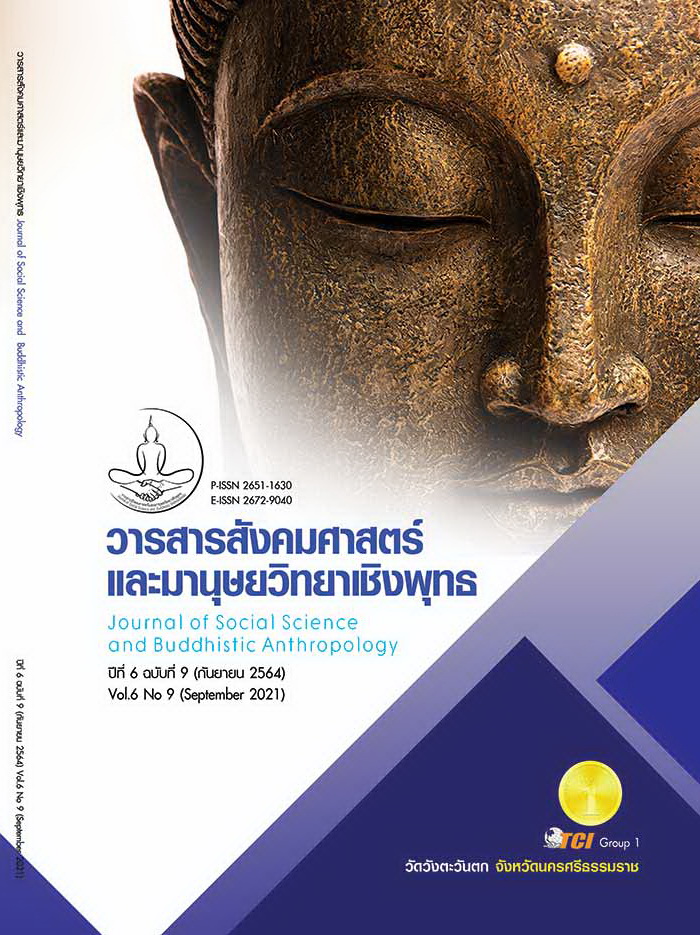THE BRAND EQUITY STRATEGIC MODEL DEVELOPMENT OF THAI ORGANIC RICE
Keywords:
Strategic Model, Brand Equity, Organic Rice ThailandAbstract
The objectives of this article were to: 1) to examine brand awareness brand association, brand perceived quality, marketing strategy and brand equity and 2) to develop the brand equity strategic model of Thai organic rice.to develop the brand equity strategic model of Thai organic rice. Mixed methods was a research approach in this study. The population consisted of participants who consumed organic rice in Thailand. The 857 samples in the quantitative research, the researcher employed the multi-stage sampling method. The research instrument utilized to collect germane data was a questionnaire. The techniques of descriptive statistics and structural equation modeling (SEM) analysis were employed. In the qualitative research, relevant data were collected by means of in-depth interviewing of 72 participants. The data collected was analyzed by the content analysis method. Findings were as follows: (1) Brand awareness and brand association had a statistically significant direct and indirect effect on brand equity. Brand perceived quality had no statistically significant direct effect on brand equity; however, it had a statistically significant indirect effect on Brand equity. Market strategy had statistically significant direct effect on Brand equity. (2) Brand equity strategic model of Thai organic rice was relevant to empirical data consist of brand awareness, brand association, brand perceived quality and brand Equity. This particular marketing strategy was hypothesized to have a mediating role. Model to measure different factors in the brand equity strategic model of organic rice was congruent with the empirical data (2 = 215.81, df = 75, p=0.000,
2/df = 2.86, CFI = 1.00, GFI = 0.97, AGFI = 0.94, RMSEA = 0.047, SRMR = 0.020).
References
กนกพร กลิ่นเกลา. (2558). พฤติกรรมการซื้อสินค้า (Shopper Behavior) และกลยุทธ์การตลาด ในแต่ละช่องทางการจำหน่ายข้าวอินทรีย์. ใน วิทยานิพนธ์บริหารธุรกิจมหาบัณฑิต สาขาวิชาการบริหารการตลาด. มหาวิทยาลัยธรรมศาสตร์.
กรมการค้าภายใน. (2563). มหัศจรรย์ข้าวไทย ความภูมิใจแห่งท้องทุ่ง. เรียกใช้เมื่อ 19 กุมภาพันธ์ 2564 จาก https://www.dit.go.th/Content.aspx?m=1120&c=31115
กัลยา วานิชย์บัญชา. (2552). สถิติสำหรับงานวิจัย. (พิมพ์ครั้งที่ 4). กรุงเทพมหานคร: ศูนย์หนังสือแห่งจุฬาลงกรณ์มหาวิทยาลัย.
ชนิตา พันธุ์มณี และคณะ. (2555). ความยินดีที่จะจ่ายและความสามารถที่จะจ่ายได้สำหรับผักสดอินทรีย์ของผู้บริโภคในจังหวัดเชียงใหม่. ใน รายงานการวิจัย. มหาวิทยาลัยแม่โจ้.
ชัยภัฏ จันทร์วิไล. (2559). นโยบายของรัฐในด้านการรักษาเสถียรภาพราคาข้าว. วารสารบัณฑิตศึกษา มหาวิทยาลัยราชภัฏสวนสุนันทา., 2(1), 32-46.
ชาคริต ดิเรกวัฒนชัย. (2554). ใครคือลูกค้าตัวจริงเสียงจริง ผู้ใช้หรือผู้ซื้อ. For Quality, 17(154), 101-103.
ธเนศ ศิริกิจ. (2563). กลยุทธ์การตลาดยุคใหม่ พฤติกรรมผู้บริโภค 2 ลักษณะ ซื้อด้วยเหตุผล ผสาน ซื้อด้วยอารมณ์. เรียกใช้เมื่อ 29 ธันวาคม 2563 จาก https://positioningmag. com/1278944
ธันย์ ชัยทร และเยาวภา ปฐมศิริกุล. (2560). รูปแบบกลยุทธ์การตลาดที่ส่งผลต่อความภักดีของลูกค้าร้านจำหน่ายสินค้าเกษตรอินทรีย์ในประเทศไทย. Veridian E-Journal, Silpakorn University (ฉบับภาษาไทย มนุษยศาสตร์ สังคมศาสตร์ และศิลปะ), 10(2), 23-45.
ปิยะวิทย์ ทิพรส และคณะ. (2561). ต้นทุนผลตอบแทนและ ดัชนีการค้าขายข้าวอินทรีย์ที่ได้รับการรับรองในประเทศไทย. วารสารสุทธิปริทัศน์, 32(104), 128-142.
พรรณภัทร มีศรีดี. (2558). การวางแผนการสื่อสารตราสินค้าระหว่างสินค้าประเภทที่มีความเกี่ยวพันสูง และสินค้าประเภทที่มีความเกี่ยวพันต่ำ (High Involvement & Low Involvement) บน Facebook Fanpage. ใน รายงานโครงการเฉพาะบุคคล วารสารศาสตร์มหาบัณฑิต สาขาวิชาการบริหารสื่อสารมวลชน. มหาวิทยาลัยธรรมศาสตร์.
มูลนิธิสายใยแผ่นดิน/กรีนเนท. (2554). พิษภัยจากสารเคมีการเกษตร. เรียกใช้เมื่อ 27 กุมภาพันธ์ 2563 จาก http://www.greennet.or.th/article/1097
ศานิต เก้าเอี้ยน และคณะ. (2558). การยกระดับมูลค่าเพิ่มข้าวหอมมะลิอินทรีย์ที่ผลิตโดยเกษตรกรรายย่อย. ใน รายงานการวิจัย. สำนักงานคณะกรรมการส่งเสริมวิทยาศาสตร์ วิจัยและนวัตกรรม.
สํานักนโยบายและวิชาการสถิติ สํานักสถิติแห่งชาติ. (2564). เทคนิคการสุ่มตัวอย่างและการประมาณค่า. เรียกใช้เมื่อ 25 มีนาคม 2564 จาก http://service.nso.go.th/nso/nsopublish/Toneminute/files/55/A3-16.pdf
สำนักควบคุมพืชและวัสดุการเกษตร. (2563). ข้อมูลสถิติวัตถุอันตราย. เรียกใช้เมื่อ 2564 กุมภาพันธ์ 9 จาก https://www.doa.go.th/ard/?page_id=85
สำนักนโยบายและยุทธศาสตร์ข้าว. (2563). ประมาณการณ์ความต้องการข้าวอินทรีย์ ปี 2563/2564 คู่มือการตรวจติดตามแผนการผลิตและการตลาดข้าวครบวงจร ปี 2563. กรุงเทพมหานคร: กรมการข้าว.
สุภมาส อังศุโชติ และคณะ. (2557). สถิติวิเคราะห์สำหรับการวิจัยทางสังคมศาสตร์และพฤติกรรมศาสตร์เทคนิคการใช้โปรแกรม LISREL.. (พิมพ์ครั้งที่ 4). กรุงเทพมหานคร: เจริญดีมั่นคง.
สุภางค์ จันทวานิช. (2552). การวิเคราะห์ข้อมูลในการวิจัยเชิงคุณภาพ. (พิมพ์ครั้งที่ 10). กรุงเทพมหานคร: สำนักพิมพ์แห่งจุฬาลงกรณ์มหาวิทยาลัย.
สุรศักดิ์ วงค์ษา. (2563). การวิจัยเชิงคุณภาพด้วยวิธีทฤษฎีฐานราก: แนวความคิดวิธีการและกรณีศึกษา. ศิลปศาสตร์ปริทัศน์, 15(1), 117-130.
Aaker, D. A. (1991). Managing Brand Equity. Capitalizing on the Value of a Brand Name. New York: Free Press.
Aaker, D. A. (1996). Building strong brands. New York: Free Press.
Adhikari, R. K. (2011). Economics of organic rice production. Journal of Agriculture and Environment, 12(1), 97-103.
Akbarov, S. (2018). Antecedents of Customer Based Brand Equity-Research in Azerbaijan. Journal of Business and Management Sciences, 6(2), 54-58.
Edwarson, W. & Scantacoloma, P. (2013). Organic supply chains for small farmer income generation in developing countries. Rome, italy: Food and Agriculture Organization of the United Nations (FAO).
Farjam, S. & Hongyi X. (2015). Reviewing the Concept of Brand Equity and Evaluating Consumer Based Brand Equity (CBBE) Models. International Journal of Management Science and Business Administration, 1(8), 14-29.
Fayrene, C. & Lee, G. C. (2011). Customer – Based Brand Equity: A literature review. Journal of Arts Science and Commerce, 2(1), 33-42.
Hidalgo-Baz, M. et al. (2017). Assessments of the Quality of Organic versus Conventional Products, by Category and Cognitive Style. Food Quality and Preference, 62(2017), 31-37.
Kapferer, J. N. (1992). Strategic brand management: New approaches to creating and evaluating brand identity. London: Kogan Page.
Keller, K. L. et al. (2008). trategic brand management: A European perspective. Harlow: Prentice Hall.
Kirmani, A. & Baumgartner, H. (2000). Reference points used in quality and value judgements. Marketing Letters, 11(4), 299-310.
Kline, R. B. (2015). Principles and practice of structural equation modeling. (4th edition). New York: Guilford publications.
Kotler, P. & Armstrong, G. (2018). Principles of Marketing, (17th Global Edition). Harlow: Pearson.
Loureiro, S. M. C. & Miranda, F. J. (2011). Brand equity and brand loyalty in the internet banking context: FIMIX-PLS market segmentation. Journal of Service Science and Management, 4(2), 476-485.
Nastasi, B. K. & Schensul, S. L. (2005). Contributions of qualitative research to the validity of intervention research. Journal of school psychology, 43(3), 177-195.
Nathan, C. & Sharon R. (2017). Rice Outlook. Economic Research Service. Retrieved February 7, 2020, from http://www.clientadvisoryservices.com/ Downloads/rcs-jul-17.pdf
Patrawart, J. (2009). Branding as the marketing mix for organic products: a case study on moral rice. Asian Journal of Food and Agro-Industry, 2(Special Issue), S256-S263.
Romaniuk, J. et al. (2017). Brand awareness: revisiting an old metric for a new world. Journal of Product and Brand Management, 26(2017), 469-476.
Statista. (2020). Total rice consumption worldwide from 2008/2009 to 2019/2020. Retrieved February 7, 2020, from https://www.statista.com/statistics/ 255977total-global-rice-consumption/
Tanveer, Z. & Lodhi, R. N. (2016). The effect of brand equity on customer satisfaction: An empirical study based on David Aaker's Brand Equity Model. IUP Journal of Brand Management, 13(3), 43-54.
Thakor, M. V. & Katsanis, L. P. (1997). A model of brand and country effects on quality dimensions: issues and implications. Journal of International Consumer Marketing, 9(3), 79-100.
United States Department of Agriculture. (2017). World Agricultural Supply and Demand Estimates. In Report. United States Department of Agriculture.
Yoo, B. & Donthu, N. (2001). Developing and validating multidimensional consumer-based brand equity scale. Journal of Business Research, 52(1), 1-14.
Yoo, B. et al. (2000). An examination of selected marketing mix elements and brand equity. Journal of the academy of marketing science, 28(2), 195-211.








